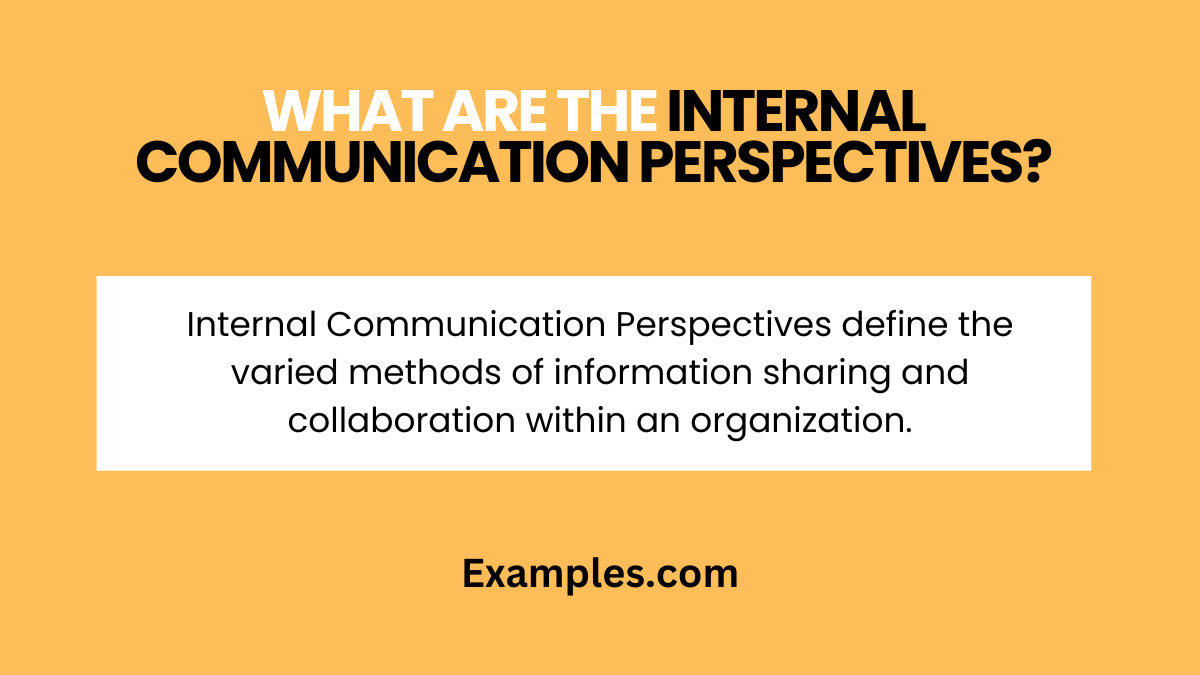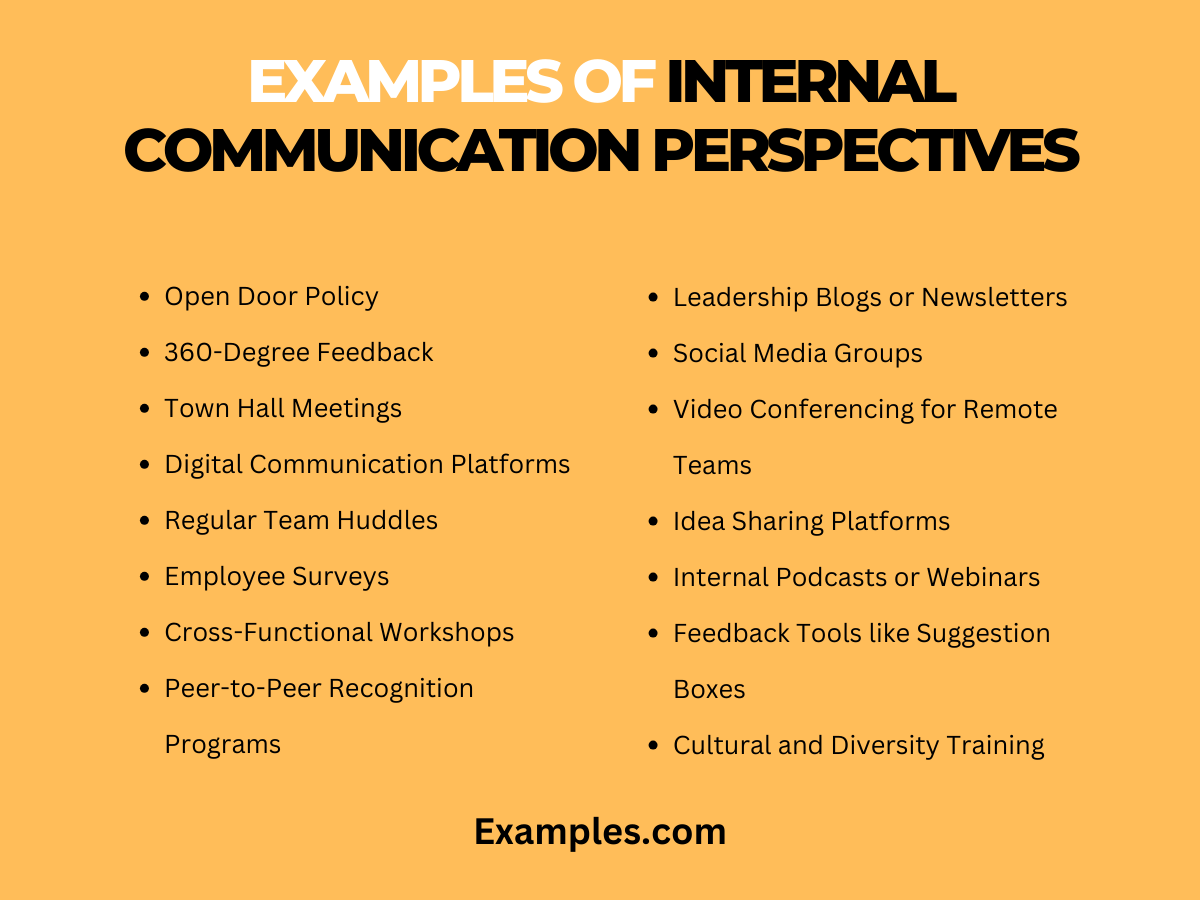14+ Internal Communication Perspectives Examples
In the intricate tapestry of organizational communication, understanding different Internal Communication Perspectives is essential. This guide presents a rich array of examples and tips, providing a comprehensive look at the various facets of internal communication within a business setting. From exploring the nuances of nonverbal cues to the complexities of digital dialogue, this resource is packed with practical insights. It’s designed to help you harness the full potential of internal communication, ensuring that every voice within your organization is heard, understood, and valued. Embark on this journey to transform your internal communication strategies and foster a more dynamic, inclusive, and effective workplace.
What are the Internal Communication Perspectives?

Internal Communication Perspectives refer to the various ways in which communication within an organization is viewed, understood, and implemented. These perspectives encompass the methods, styles, and approaches used to share information, ideas, and feedback among employees and management. They play a crucial role in shaping how effectively a team collaborates, how well information is disseminated, and how aligned the employees are with the organization’s goals. Understanding these perspectives is vital for creating a cohesive and productive work environment where effective, transparent, and open communication thrives.
15 Examples of Internal Communication Perspectives

Exploring Internal Communication Perspectives offers invaluable insights into effective workplace dialogue. This guide unveils 15 unique perspectives, each with a distinct approach to enhancing communication within an organization. These examples range from traditional face-to-face interactions to modern digital solutions, showcasing the diversity and adaptability of internal communication strategies. Whether you’re looking to strengthen team bonds, improve information flow, or foster a culture of open dialogue, these perspectives provide practical, actionable examples for any organizational context.
- Open Door Policy: Encourages transparency and approachability within the organization.
- Example: “Feel free to stop by my office anytime to discuss any concerns or ideas you have.”
- 360-Degree Feedback: Facilitates comprehensive feedback from all levels of the organization.
- Example: “Your feedback is important. Please provide your thoughts on the project from your perspective.”
- Town Hall Meetings: Provides a platform for management to communicate with all employees.
- Example: “Join our quarterly town hall meeting to hear about the company’s progress and future plans.”
- Digital Communication Platforms: Utilizes tools like Slack or Microsoft Teams for real-time messaging and collaboration.
- Example: “Let’s continue this discussion on our team’s Slack channel to include everyone’s input.”
- Regular Team Huddles: Short, frequent meetings to keep everyone aligned and informed.
- Example: “Let’s have a quick huddle every morning to update each other on our daily tasks.”
- Employee Surveys: Collects anonymous feedback for honest and open communication.
- Example: “Please fill out this survey to share your thoughts on our new internal policy.”
- Cross-Functional Workshops: Encourages collaboration and communication between different departments.
- Example: “We’re hosting a workshop next week to brainstorm solutions with the marketing team.”
- Peer-to-Peer Recognition Programs: Allows colleagues to acknowledge each other’s contributions.
- Example: “Nominate a teammate for the monthly ‘Star Performer’ award to recognize their hard work.”
- Leadership Blogs or Newsletters: Shares insights and updates from the company’s leadership.
- Example: “Read this month’s CEO newsletter to understand our strategic priorities and achievements.”
- Social Media Groups: Creates informal platforms for employees to connect and share.
- Example: “Join our company’s Facebook group to stay updated and engage with your colleagues.”
- Video Conferencing for Remote Teams: Connects distributed teams through virtual face-to-face meetings.
- Example: “Let’s schedule a weekly Zoom call to ensure our remote team members stay connected.”
- Idea Sharing Platforms: Online forums or platforms where employees can propose and discuss new ideas.
- Example: “Post your innovative ideas on our IdeaShare platform and collaborate with others to develop them.”
- Internal Podcasts or Webinars: Provides educational and informational content in an engaging format.
- Example: “Tune into our monthly webinar to learn about the latest trends in our industry.”
- Feedback Tools like Suggestion Boxes: Encourages anonymous suggestions for improvement.
- Example: “Feel free to drop your suggestions in the box in the break room.”
- Cultural and Diversity Training: Promotes understanding and respect for diverse perspectives.
- Example: “Attend our cultural sensitivity training to better understand and appreciate our diverse workforce.”
Internal Communication Perspectives in Business
- Top-Down Communication: This traditional approach involves information flowing from management to employees. It emphasizes clarity and consistency in conveying company goals and policies, ensuring that every member is aligned with the organization’s vision.
- Horizontal Communication: Equally important is peer-to-peer communication among employees at the same level. This perspective focuses on collaboration and information sharing, fostering teamwork and interpersonal communication.
- Feedback-Oriented Communication: Modern businesses increasingly adopt a feedback-oriented approach. This involves actively seeking and responding to feedback from employees, which is essential for continuous improvement and addressing communication barriers.
- Digital-First Communication: With the advent of communication technology, many businesses now prioritize digital channels for internal communication. This perspective values speed and accessibility, utilizing tools like emails, intranets, and messaging apps to keep employees connected.
- Culture-Driven Communication: Some businesses view internal communication as a tool to nurture and disseminate their corporate culture. This involves using communication to reinforce company values and build a sense of community among employees.
Employee Perspectives of Internal Communication
- Need for Clarity and Transparency: Employees often desire clear, transparent communication from the leadership. This includes straightforward information about company changes, decisions, and future plans.
- Preference for Two-Way Communication: Many employees value a two-way communication channel where they can voice their opinions and receive responses. This reflects a need for dialogue rather than a monologue in internal communication.
- Desire for Recognition and Involvement: Employees appreciate when their contributions are recognized and when they are involved in decision-making processes. This perspective highlights the importance of inclusive communication strategies.
- Expectation of Timely Information: Timeliness in communication is crucial for employees. Delayed information can lead to rumors and uncertainty, negatively impacting morale and productivity.
- Valuing Personalized Communication: Employees often prefer communication that acknowledges their individual roles and contributions. This personalized approach can enhance the relevance and effectiveness of internal messages.
How to Explain Internal Communication Perspectives?
- Identify Different Communication Styles: Begin by outlining the various styles, such as assertive, passive, and aggressive, and how they manifest in a workplace setting. This helps in understanding the dynamics of internal communication.
- Discuss Communication Channels: Explain the role of different communication channels, like face-to-face meetings, digital platforms, and written communication. Highlight how each channel serves specific purposes and audiences.
- Emphasize the Importance of Feedback: Illustrate how feedback mechanisms, both formal and informal, contribute to effective internal communication. Discuss how they help in identifying issues and improving communication strategies.
- Link Communication to Organizational Goals: Explain how internal communication is tied to achieving business objectives. Discuss how effective communication can lead to better team coordination, higher employee engagement, and ultimately, organizational success.
- Address the Role of Nonverbal Communication: Nonverbal cues like body language and tone play a significant role in communication. Discuss their impact on understanding and interpreting messages within a business context.
What are the Different Perspectives in Internal Communication?
- Strategic Perspective: Views internal communication as a strategic tool to achieve organizational goals. It involves planning communication to align employees with the company’s mission and objectives.
- Relational Perspective: Focuses on building relationships among employees and between employees and management. This perspective values trust, openness, and mutual respect in communication.
- Cultural Perspective: Emphasizes the role of communication in shaping and maintaining organizational culture. It involves using communication to disseminate core values and norms among employees.
- Network Perspective: Analyzes the patterns of communication within an organization. It involves studying how information flows through formal and informal networks and identifying areas for improvement.
- Change Management Perspective: Focuses on the role of internal communication in supporting organizational change. It involves using communication to facilitate understanding, reduce resistance, and encourage adaptation among employees.
In summary, this article on Internal Communication Perspectives provides a detailed guide to understanding and implementing various communication strategies within an organization. It highlights the importance of adapting to different communication styles, embracing digital advancements, and prioritizing feedback and employee involvement. Embracing these perspectives can significantly enhance workplace harmony, employee engagement, and overall organizational effectiveness.



